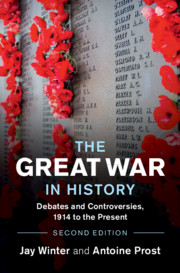Refine search
Actions for selected content:
15401 results in Military history
Introduction
-
- Book:
- Love between Enemies
- Published online:
- 06 November 2020
- Print publication:
- 19 November 2020, pp 1-26
-
- Chapter
-
- You have access
- HTML
- Export citation
Copyright page
-
- Book:
- Love between Enemies
- Published online:
- 06 November 2020
- Print publication:
- 19 November 2020, pp iv-iv
-
- Chapter
- Export citation
Bibliography
-
- Book:
- Love between Enemies
- Published online:
- 06 November 2020
- Print publication:
- 19 November 2020, pp 361-377
-
- Chapter
- Export citation
8 - Memory
-
- Book:
- Love between Enemies
- Published online:
- 06 November 2020
- Print publication:
- 19 November 2020, pp 339-353
-
- Chapter
- Export citation
1 - The Prisoners of War and the German Women
-
- Book:
- Love between Enemies
- Published online:
- 06 November 2020
- Print publication:
- 19 November 2020, pp 27-52
-
- Chapter
-
- You have access
- HTML
- Export citation
Contents
-
- Book:
- Love between Enemies
- Published online:
- 06 November 2020
- Print publication:
- 19 November 2020, pp vii-viii
-
- Chapter
- Export citation
Abbreviations
-
- Book:
- Love between Enemies
- Published online:
- 06 November 2020
- Print publication:
- 19 November 2020, pp xii-xiii
-
- Chapter
- Export citation
5 - The Trials
-
- Book:
- Love between Enemies
- Published online:
- 06 November 2020
- Print publication:
- 19 November 2020, pp 206-248
-
- Chapter
- Export citation
3 - The Relations
-
- Book:
- Love between Enemies
- Published online:
- 06 November 2020
- Print publication:
- 19 November 2020, pp 93-139
-
- Chapter
- Export citation
4 - Discovery
-
- Book:
- Love between Enemies
- Published online:
- 06 November 2020
- Print publication:
- 19 November 2020, pp 140-205
-
- Chapter
- Export citation
Acknowledgments
-
- Book:
- Love between Enemies
- Published online:
- 06 November 2020
- Print publication:
- 19 November 2020, pp ix-xi
-
- Chapter
- Export citation

The Great War in History
- Debates and Controversies, 1914 to the Present
-
- Published online:
- 16 November 2020
- Print publication:
- 03 December 2020
Dedication
-
- Book:
- The Unknown Enemy
- Published online:
- 06 November 2020
- Print publication:
- 12 November 2020, pp v-vi
-
- Chapter
- Export citation
8 - Political Warfare in Afghanistan: Helmand Province, 2006–12
-
- Book:
- The Unknown Enemy
- Published online:
- 06 November 2020
- Print publication:
- 12 November 2020, pp 165-195
-
- Chapter
- Export citation
4 - ‘Peaceful Penetration’ on the North-West Frontier, 1919–39
-
- Book:
- The Unknown Enemy
- Published online:
- 06 November 2020
- Print publication:
- 12 November 2020, pp 67-88
-
- Chapter
- Export citation
1 - Culture Warriors
-
- Book:
- The Unknown Enemy
- Published online:
- 06 November 2020
- Print publication:
- 12 November 2020, pp 1-23
-
- Chapter
- Export citation
3 - Knowledge, Influence and Control
-
- Book:
- The Unknown Enemy
- Published online:
- 06 November 2020
- Print publication:
- 12 November 2020, pp 46-66
-
- Chapter
- Export citation
Contents
-
- Book:
- The Unknown Enemy
- Published online:
- 06 November 2020
- Print publication:
- 12 November 2020, pp vii-viii
-
- Chapter
- Export citation
7 - Political Warfare in Iraq: Al Anbar and Basra, 2006–9
-
- Book:
- The Unknown Enemy
- Published online:
- 06 November 2020
- Print publication:
- 12 November 2020, pp 138-164
-
- Chapter
- Export citation
Copyright page
-
- Book:
- The Unknown Enemy
- Published online:
- 06 November 2020
- Print publication:
- 12 November 2020, pp iv-iv
-
- Chapter
- Export citation
